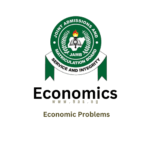OBJECTIVES
1. The type of production that involves the tapping and harnessing of natural resources is
A. primary production. B. secondary production. C. tertiary production. D. industrial production.
2. The three broad categories of production are
A. direct, secondary and extractive. B. primary, tertiary and direct. C. primary, secondary and tertiary. D. secondary, primary and indirect.
3. Subsistence production means that goods and services are
A. produced for consumption only. B. sold to others. C. sold in the country. D. produced for the market.
4. Mining is an example of
A. tertrary production. B. primary production. C. secondary production. D. advanced production.
5. Production covers all the following except when
A. utility is created. B. a good is manufactured. C. a commodity is consumed. D. individual wants are satisfied.
6. Basic extractive activities are classified as
A. manufacturing production. B. tertiary production. C. secondary production. D. primary production.
7. A tent-making factory offers
A. personal services. B. indirect services. C. social services. D. reflex services.
8. In Economics; production is complete when
A. goods are produced in the factories. B. goods are sold-to wholesalers. C. prices are fixed for goods and services. D. goods and services reach the consumers.
9. In developing countries, a larger percentage of the labour force is employed in the
A. trade sector. B. tertiary sector. C. primary sector. D. secondary sector.
10. Farming, mining and fishing are
A. primary production. B. secondary production. C. tertiary production. D. intermediate production.
11. In Economics, production is complete when
A. goods are manufactured in the factories. B. commodities arrived to the final consumer. C. goods and services are distributed by the government. D. goods and services get to the retailers.
12. The creation of utility can be referred to as
A. value added. B. profit maximization. C. entrepreneurship. D. production.
13. The term production in Economics means
A. manufacturing of goods. B. the creation of utilities. C. giving birth to children. D. the distribution of goods and service.
14. Provision of services is classified under
A. primary production. B. secondary production. C. tertiary production. D. production possibilities.
15.Which of the following may not be included in explaining the term production?
A. Provision of services. B. manufacture of goods. C. Changing raw . materials to finished goods. D. Use of consumer goods.
16. Production is not complete until the
A. goods get to the wholesalers. B. goods reach the final consumer. C. factors of production are combined. D. goods are ready for transportation.
17. Manufacturing involves the process of
A. making goods available. B. providing finished products. C. changing items to new states. D. producing capital goods only.
18. An example of a producer good is a
A. tin of milk. B. hammer. C. loaf of bread. D. shirt.
19. A carpenter’s consumer goods include I. a kilogram of rice Il. 3 pairs of shoes Ill. 4 pairs of socks IV. 3 screw-drivers
A. I, and IV only. B. I, II, III and IV. C. I, Il and IV only. D. I, Il and III only.
20. Goods which have to be paid for are known as
A. physical goods. B. economic goods. C. free goods. D. intangible goods.
21. The following are examples of economic goods except
A. bottled water. B. air. C. household utensils. D. shelter.
22. An economic good is described as a good which
A. yields utility and commands a price. B. is useful and occupies a space. C. Is in high demand and transferable. D. has unlimited supply.
23. The major employer of labour in developing countries is the
A. tertiary sector. B. secondary sector. C. primary sector. D. industrial sector.
24.Which of the following are intermediate products?
A. Cement and steel B. Furniture and shirt C. Handkerchief D. shoe.
25. The exploitation of mineral resources constitutes which form of production?
A. Primary production. B. Secondary production. C. Tertiary production. D. Services production.
26.Warehousing is an economic activity that falls under
A. tertiary production. B. intermediate production. c. secondary production. D. primary production.
THEORY
1. Highlight the economic problems associated with the dependence of West African countries on primary production.
2. (a)What is meant by production? (b) Explain with examples, the following types of production (i) Primary (ii) Secondary (iii) Tertiary.
3. (a) Explain with examples the following types of production: (i) Primary (il) Secondary (ili) Tertiary (b) Give two reasons why primary production pre-dominates in developing countries
4. The following are the loans granted by a commercial bank to different categories of individuals. Use the information to answer the questions that, follow: Bakers $8,000, Farmers $8,000, Miners $7,000, Retailers $5,000, Tailors $4,000, Teachers $6,000, Drivers $4,000, Fishermen $3,000. (a) Arrange the information in the form of a table grouping the individuals into: (i) Primary Sector (ii) Secondary Sector (iii) Tertiary Sector. (b) Express the loan to each sector as a ratio of the total loan granted. (c) Present the total loans granted to the sectors in a simple bar chart. (Use of graph sheet is essential).
5.What are capital goods?
6. Define consumer goods?



Kasımpaşa su kaçak tespiti Başakşehir’deki apartmanda su kaçağı vardı, ekip çok profesyonel ve hızlı çalıştı. https://www.otosanayibul.com/ilanlar/uskudar-su-tesisatcisi/